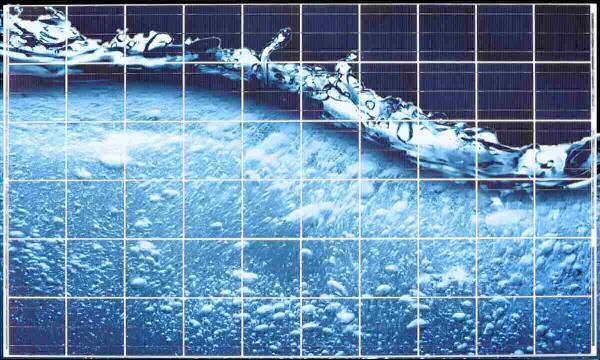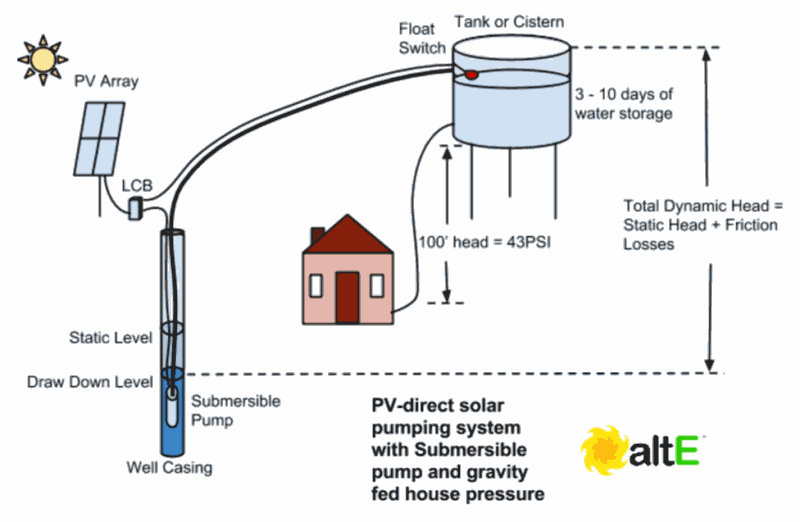
This is the first part of our blog series on solar water pumping that introduces to you the different types of solar water pumps. Our second post in this series covers the details on how to size a solar water pumping system.
Solar Water Pumps – the Solution to Pumping without Electrical Lines
Solar water pumps enable you to move water from its remote source to where you need it, without access to power lines. Solar pumping has three primary uses; domestic use for washing, cooking and drinking, livestock watering, and irrigation. The same basics are used for all three requirements, although domestic use may require additional capabilities. We’ll discuss domestic use for this blog. We’ll cover irrigation and livestock in a future blog post. Solar water pumps are different from regular AC powered pumps in more ways than the simple fact that they use DC power instead of AC. Most solar pumps are designed to be used in off-grid situations, and are designed to be extremely efficient. By not experiencing losses when going from DC to AC and back to DC, you can maximize your pumping while minimizing your power use. The most efficient way to use a solar pump is PV-direct, powering the pump directly off the solar panel, without using batteries. Rather than experiencing losses through storing power in batteries, the water itself is stored in a cistern or tank to be used when needed. It’s much easier to store water than power. The difference between a cistern and a tank is a cistern has a removable lid, and a tank is generally sealed.
Submersible Solar Pumps vs Surface Pumps

Submersible solar pump (left) versus a surface pump (right).
Solar water pumps are typically divided into two categories: submersible pump and surface pump. A submersible pump is installed under water, usually in a well, but can also be in a pond or stream if raised off the bottom. A surface pump is installed above the water, with an intake hose feeding the pump from the water source, and the output hose feeding the tank. Pumps are able to push water out much higher than they are able to suck water in, so the they need to be close to the water source. Keep the head, or the height difference between the water and the pump,as low as possible.
Morning Boost
Most of us need a boost to get going in the morning; a solar pump is no different. Pumps generally require a high surge in current when starting up, but not a lot of voltage. As a result, when solar pumps are starting in the dim, morning light, it can sometimes have trouble getting started. A Linear Current Booster (LCB) is a device that can be installed between the solar panel array and the pump to increase the current output to get the pump going in lower light. It does so by dropping the voltage output, which doesn’t affect the water flow as much as current does. This will allow pumping to begin earlier in the day, and continue later in the afternoon as the sun is heading down – giving you more water pumped overall during the day.
Let me float this idea by you…
A float switch can be connected to control when to turn the pump on or off based on the water level. A pump up switch will turn the pump on when the tank is low, and off when it is full. It is also known as a full tank shut off switch. A pump down float will turn on the pump when the tank is full, and off when it is empty. It is also known as an empty tank shut off switch. Some LCBs have the ability to connect a float switch input to it, rather than directly to the pump. Be sure to check the manual of the LCB, as the on/off behavior may change when using a float switch with certain LCBs. 
Under Pressure
When providing water for a house, water pressure must be created to allow the water to flow inside the pipes. A typical house has 40 PSI (pounds per square inch) of pressure, although, as low as 20 PSI may be adequate for your needs. Water pressure can be achieved a few ways. Gravity feed is the most basic method; where the water is stored in a tank higher than the house. Every foot of head is equal to 0.433 PSI. If the tank is 100’ high, it will provide 43 PSI of water pressure for your house (100’ x .433 = 43.3 PSI).
| Feet Head of Water to PSI | |||||||
| Ft. Head | PSI | Ft. Head | PSI | Ft. Head | PSI | ||
| 1 | 0.43 | 20 | 8.66 | 80 | 34.6 | ||
| 2 | 0.87 | 30 | 13 | 90 | 39 | ||
| 3 | 1.3 | 40 | 17.3 | 100 | 43.3 | ||
| 4 | 1.73 | 50 | 21.6 | 200 | 86.6 | ||
| 5 | 2.17 | 60 | 26 | 500 | 216 | ||
| 10 | 4.33 | 70 | 30.3 | 1000 | 433 | ||
Booster Pump for House Pressure
If a high storage tank isn’t possible, a smaller booster pump can be added to the system to pressurize the pipes. This pump would have to be connected to the battery bank to allow pressurizing at any time of day or night. The booster pump technical specs will show the PSI capability and how many amps are needed to create the pressure.  This should provide a general overview of solar pumping. Stay tuned for our next blog where we demonstrate how to select the right solar water pumps for your off-grid house. Please contact us at the altE Store for help designing your solar water pumping system.
This should provide a general overview of solar pumping. Stay tuned for our next blog where we demonstrate how to select the right solar water pumps for your off-grid house. Please contact us at the altE Store for help designing your solar water pumping system.
Continue on to Part 2 – Sizing a Solar Water Pumping System…

I need to install Solar water pumping. The power audit for the borehole water pump machine is 0.5HP which is 373Watt . what are your recommendations for this Solar Water Pumping little job. i will like to add AGM battery as backup in case of bad weather times ?
Wish Amy Beaudet should give a full items to buy and installation advice , video tutorial will be appreciated
We have a questionnaire that can help us determine what equipment you need for pumping. Please complete it here, https://www.altestore.com/store/info/solar-pump-questionnaire// , and our technical sales team can help you out.
Amy is actually writing a solar water pumping video script right now, and hopes to release a video soon. Thanks for your suggestion.
Pingback: How to Size a Solar Water Pumping System | altE Bog
I need your professional input for a project on the right inverter, solar panel, solar charge controller to order from altestore. the project is 6000watts load, 10,000 watts recommended for 12hours runtime.
please send your email. Thanks.
The best way to ask for help on a project is to go to our our contact page at https://www.altestore.com/store/info/email-us/ and enter your information. Someone from technical sales can help you out from there. Note that they will need to know what country the system is to be installed in, so the correct inverter can be chosen, and the right number of sun hours determined.